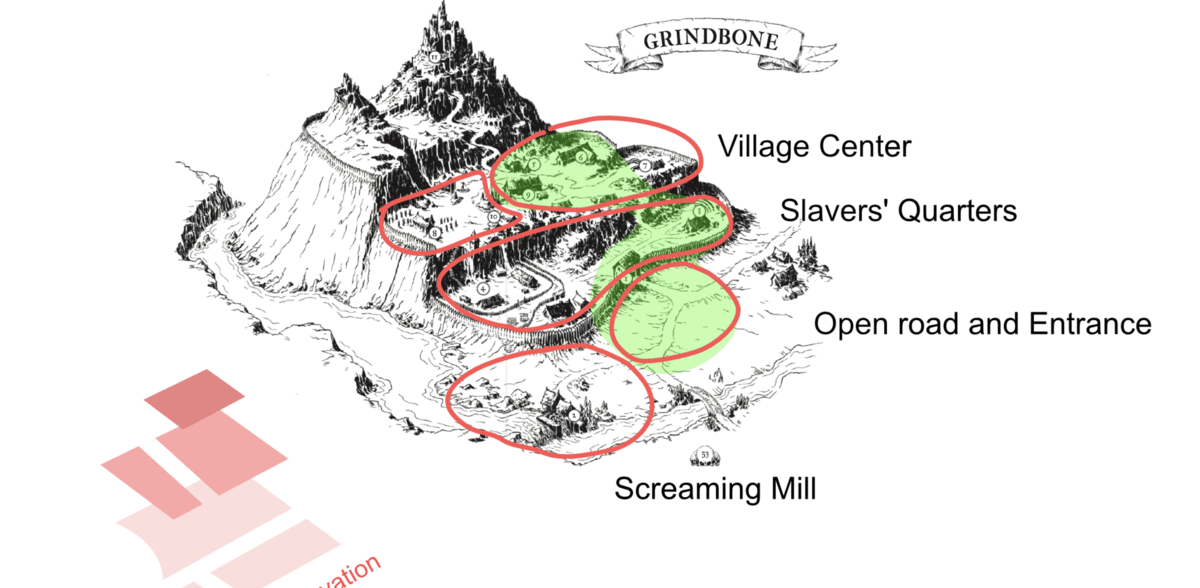A fast-paced City Builder, in pocket-sized world.
Projects
Forbidden Lands
The CRPG adaption of the award-winng table-top game

Genre: Fantasy Computer Role-Playing Game (CRPG)
Studio: Epic Tellers (Website)
Team: 10
Duration: 6 months
My role: Level Designer, Technical Game Designer
Tools: Godot Engine / GDScript, Blender, Git, Python, GLSL
Forbidden Lands is a demo adaptation of the award-winning tabletop role-playing game (TTRPG) of the same name.
I entered the Epic Tellers studio during the first steps of the project to work as the level designer on the two levels of the vertical slice.
The project is unpublished, but a retrospective presentation by the current team can be found here: CRPG retrospective - GodotCon 2024
Epictellers Entry Test
My entry test provided the starting point for the project's level design workflow and tooling.
Full breakdown available here: Grindbone Level Design Test

The Entry Test provided a starting point for the level design workflow
Level Design Workflow
The level design workflow consisted of the following steps:
- Define Goals and Constraints
- Search for References
- Sketching
- Blockout
- Implement Gameplay Interactions (dialogue and combat triggers, lootables, vista points, camera transitions, climb points, etc.)
- First Pass Beautification (reference research, asset finding, asset placement, lighting)
For more details, see the full Level Design Workflow.
As we were prototyping a CRPG from scratch, my work also revolved around testing and adapting level design to core features rolled out by the team (navigation, dialogues, combat) and designing and implementing a dynamic camera system that fit our gameplay and level design goals (see section below for more).
Level 1 sketches, exploring both formal concepts and flow, leading to a layout for blockout.

From layout to first pass beautification
Screen-based Flow Design
Designing CRPG levels, focusing on a top down 3rd person camera, cinematic moments, vertical view points and tactical combat, we took inspiration from games such as Diablo IV or Baldur's Gate 3, focusing on a screen-per-screen progression, and making sure that each moment has either a visually striking view, narrative events, or gameplay interactions.

The levels were designed so that each camera view has something to do or look at.
Each rectangle above corresponds to a camera view and a set activity.

Trigger Maps helped us plan and iterate on the flow, and the narrative and gameplay beats of the levels.
"Down-South XYZ" Map Layout
Studying top-down ARPGs and CRPGs, we decided on a fixed camera centered on the active character, with two levels of zoom but no rotational freedom.
The angle and distance of the camera focused on combat gameplay, navigation, clear composition, and environmental storytelling.
Restricting both camera movement and the up-axis rotation meant more consistency in our ability to direct the player's attention and deliver an environment-based story. However, this also added strong restrictions on the way the levels needed to be built.
To accommodate this choice, the level design focused on these two principles:
- Lower pathways are always south of higher ones (to avoid obfuscation),
- Pathways are never oriented North/South (to avoid low visibility on upcoming enemies).
This results in a layout made of X, Y, or Z-looking pathways and south-facing drop-downs.

Pathways take on an XYZ shape and are stacked according to their elevation (high=North, low=South).
Dynamic Camera System
To give ourselves more freedom in designing interesting levels, I designed a dynamic camera that allowed us to smoothly interpolate both camera distance and up-axis rotation according to where the player characters are located.
While we avoided any drastic camera movement, this did allow us to bend the "down-south XYX" rule, as well as offer better vista moments and place larger scaled points of interest in the world.

Prototyping a dynamic camera early in the development process
helped us identify level design affordances and constraints.
Pluri-disciplinary Contribution
I had the opportunity of working with an amazing team of developers and artists, each of us contributing as much as we could to all aspects of the project.
In this context, I also prototyped technical art solutions during the beautification phase of the level design process, like a waterfall made of a volemtric fog volume, a particle system, animated sprites, and fragment and vertex shader.
Full breakdown here.

